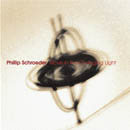|

Move In the Changing Light
by Phillip Schroeder
|
“Move In the Changing Light” is a fascinating new release
from Phillip Schroeder. Ambient and experimental, this music would
very definitely fall under the category of “contemporary classical.” A
Professor of Music at Henderson State University in Arkansas, Schroeder
brings a richly varied musical experience to his music that makes it
both intellectual and accessible. Unlike his previous release, “Music
for Piano,” which was solo piano, this CD incorporates a great
deal of digital wizardry that allows Schroeder to play as many as five
pianos at a time. (Before I read the liner notes, I couldn’t
figure out how anyone could sustain trills and tremolo for such a long
period of time without massive cramps in the arms and wrists!) The
effect is of shimmering sounds that are really quite soothing despite
the massive quantity of notes in various passages. The seven tracks
vary in length from fifty-nine seconds to almost sixteen minutes, giving
them time to open up and evolve. In addition to the piano(s), Schroeder
is featured on synthesizer, electric bass, and percussion. He is joined
by soprano Amy McGinty and baritone Robert Best singing wordless vocals,
and Daniel Cline on cello. The sound is rich and full, and the complexity
is subtle.
The CD opens with “Move in the Changing Light 2,” which features
multi-track soprano, five pianos with digital delays, and synthesizer. The piano
sounds are made up of layers, some a rapid filigree effect, and others more floating.
The ethereal soprano voice combines to create a feeling of vast space and sparkling
light. This work is almost thirteen minutes, and some passages seem to float
with others a bit more percussive. Despite the agitation of the piano, the overall
effect is very relaxing and peaceful. “Rising, See the Invisible” is
darker and more intense. Robert Best’s baritone is a passionate instrument
in the ensemble comprised of cello, two pianos, synth, and vibraphone. The repeated
note on the vibraphone throughout the piece evokes a sense of urgency, and the
cello’s voice is mournful. The depth of emotion in this piece is stunning. “Where
Joy May Dwell” is a piece for two pianos and two pianos with digital delays.
The shimmering underpinnings are similar to the first track, with a much slower,
simpler piano over the top. As the piece develops, some of the shimmering comes
to the foreground, and the interplay between the two continues throughout the
just-under sixteen-minute piece. Schroeder again creates the feeling of vast
space and openness. “This We Have” includes soprano, three pianos,
one piano with digital delays, synth, and electric bass. The music seems to float
peacefully on a cloud or on gentle water - gorgeous! The CD closes with the original
version of the title track. This version has the same instrumentation without
the soprano. It’s very interesting to hear the piece without the calming
voice - much more agitato, but still gently glistening in the light.
The Innova website suggests: “Draw the blinds, draw a bath, and let your
mind take this gentle voyage.” I couldn’t have said it better! Far
from ear candy, “Move in the Changing Light” could be too much of
a challenge for some listeners, but if you are interested in something different
and substantial, I highly recommend it.
Reviewed
by Kathy Parsons reprinted from Mainly
Piano on
Ambient Visions
|
|